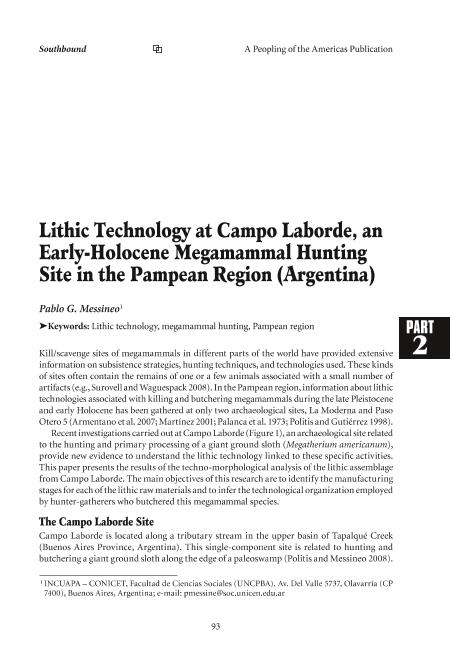Artículo
Lithic Technology at Campo Laborde, an Early-Holocene Megamammal Hunting Site in the Pampean Region (Argentina)
Fecha de publicación:
11/2012
Editorial:
University of Texas A&M. Department of Anthropology. Center for the Study of the First Americans
Revista:
Current Research in the Pleistocene
ISSN:
8755-898X
Idioma:
Inglés
Tipo de recurso:
Artículo publicado
Clasificación temática:
Resumen
Kill/scavenge sites of megamammals in different parts of the world have provided extensive information on subsistence strategies, hunting techniques and technologies used. These kinds of sites often contain the remains of one or a few animals associated with small artifacts. In the pampean region, the knowledge of the lithic technologies associated with the kill/procurement and butchering of megamammals during the Late Pleistocene and Early Holocene has been studied in only two other archaeological assemblages: La Moderna and Paso Otero 5. Recent investigations carried out at Campo Laborde, an archaeological site related with the hunting and the primary processing of a giant ground sloth (Megatherium americanum), provide new evidence to understand the lithic technology linked to these specific activities. In this paper, the results of the techno-morphological analysis of the lithic assemblage from Campo Laborde will be presented. The main objectives of this research are to identify the manufacturing stages for each of the lithic raw materials, and to infer the technological organization employed by the hunter-gatherers during the butchering of this megamammal specie.
Palabras clave:
KILL/SCAVENGE SITE
,
EARLY HOLOCENE
,
LITHIC TECHNOLOGY
,
HUNTER-GATHERERS
Archivos asociados
Licencia
Identificadores
Colecciones
Articulos(INCUAPA)
Articulos de INVESTIGACIONES ARQUEOLOGICAS Y PALEONTOLOGICAS DEL CUATERNARIO PAMPEANO
Articulos de INVESTIGACIONES ARQUEOLOGICAS Y PALEONTOLOGICAS DEL CUATERNARIO PAMPEANO
Citación
Messineo, Pablo Geronimo; Lithic Technology at Campo Laborde, an Early-Holocene Megamammal Hunting Site in the Pampean Region (Argentina); University of Texas A&M. Department of Anthropology. Center for the Study of the First Americans; Current Research in the Pleistocene; 11-2012; 93-97
Compartir




